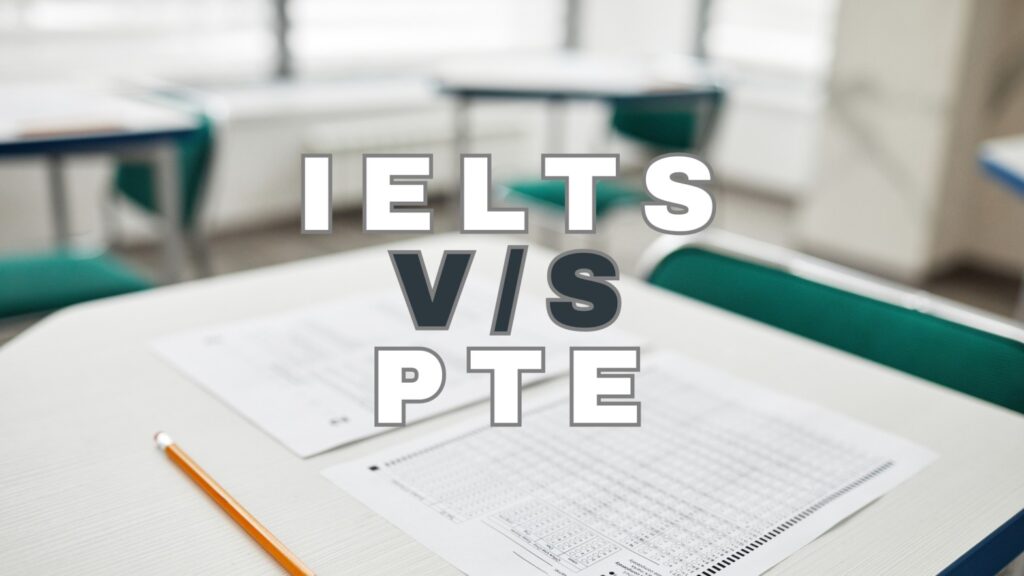
If you’re planning to study abroad, one of the first steps in your journey is proving your English language proficiency—and for most international students, that means choosing between two of the most popular exams: PTE (Pearson Test of English) and IELTS (International English Language Testing System). While both tests are widely accepted by universities, visa authorities, and employers around the world, they differ significantly in format, scoring, and overall experience.
Naturally, one of the most common questions students ask is: Which one is easier? The answer depends on your personal strengths, learning style, and how comfortable you are with computer-based testing versus traditional pen-and-paper exams.
In this blog, we’ll break down the key differences between PTE and IELTS—from test structure and scoring to pros, cons, and ease of preparation—so you can decide which one aligns best with your goals and gives you the best shot at success.
1. Test Format and Structure
IELTS:
- Types: IELTS Academic (for students) and IELTS General Training (for migration/work).
- Sections: Listening, Reading, Writing, and Speaking.
- Duration: Approximately 2 hours 45 minutes.
- Speaking Test: Conducted face-to-face with a human examiner.
PTE:
- Types: PTE Academic, PTE Academic UKVI, and PTE Home.
- Sections: Speaking & Writing (combined), Reading, and Listening.
- Duration: Around 2 hours (PTE Academic).
- Speaking Test: Conducted through a computer using AI speech recognition.
Key Difference: IELTS uses a human examiner for speaking, while PTE is entirely computer-based.
2. Scoring System
IELTS:
- Band Scale: 0 to 9 (in 0.5 increments).
- Scoring: Each section is scored individually, and the average gives your overall band.
PTE:
- Score Range: 10 to 90.
- Scoring: Based on automated AI evaluation across all sections, including speaking and writing.
Key Difference: IELTS has human scoring; PTE is fully automated, which can lead to faster and more consistent results.
3. Which Test Is Easier?
This depends on you. Here’s how to decide:
| If you are good at… | You may prefer… |
| Typing quickly and using computers | PTE |
| Speaking without nervousness | IELTS |
| Handling integrated tasks (e.g. listen and summarize) | PTE |
| Familiar formats and direct questions | IELTS |
General Observations:
- Many students say PTE feels more “objective” because scoring is automated.
- IELTS gives you the advantage of a more human touch, especially in writing and speaking evaluations.
- If you’re a fast typist and prefer not dealing with handwriting or face-to-face interviews, PTE might feel easier.
- If you’re a strong communicator who does well in structured environments, IELTS may suit you better.
4. Key Differences between PTE & IELTS
a. Speaking Section
- PTE: You speak into a microphone and are assessed by AI. This can feel less intimidating for shy students.
- IELTS: Speaking is done face-to-face with a human examiner. This may be more natural for those comfortable in conversation but stressful for others.
b. Writing Section
- PTE: Writing tasks are typed, and grammar/spelling are evaluated by software.
- IELTS: You write essays by hand (or type, if computer-based), and human evaluators look for structure, vocabulary, and coherence.
c. Listening Section
- PTE: Includes integrated questions where you may have to summarize spoken content.
- IELTS: You listen to audio clips and answer specific questions—some find it more predictable.
d. Reading Section
- Both tests have multiple-choice and gap-fill questions. PTE often integrates reading with other skills (like reading & speaking together), while IELTS keeps it separat
5. PTE vs IELTS: Exam Fees (2024)
The cost of taking an English proficiency test is an important factor for students. Here’s a fee comparison for PTE and IELTS in different countries:
| Country | PTE Academic Fee (Approx.) | IELTS Fee (Approx.) |
| India | ₹16,500 – ₹17,700 | ₹17,000 – ₹18,500 |
| USA | $200 – $220 | $245 – $275 |
| UK | £180 – £200 | £195 – £220 |
| Australia | AUD $410 – $450 | AUD $395 – $430 |
Conclusion
Both PTE and IELTS are excellent tests with global recognition. The best choice for you depends on your personal preferences, comfort with technology, and the specific requirements of the country or institution you’re applying to.
Still unsure? Take practice tests for both to see which format suits you better. After all, the right test can give you a smoother journey to your international goals.









